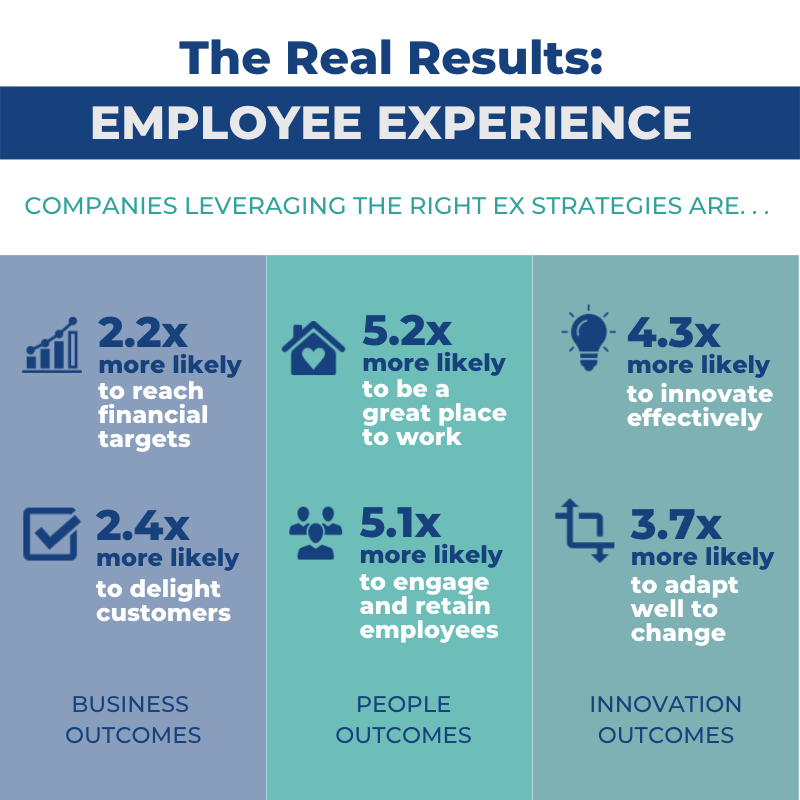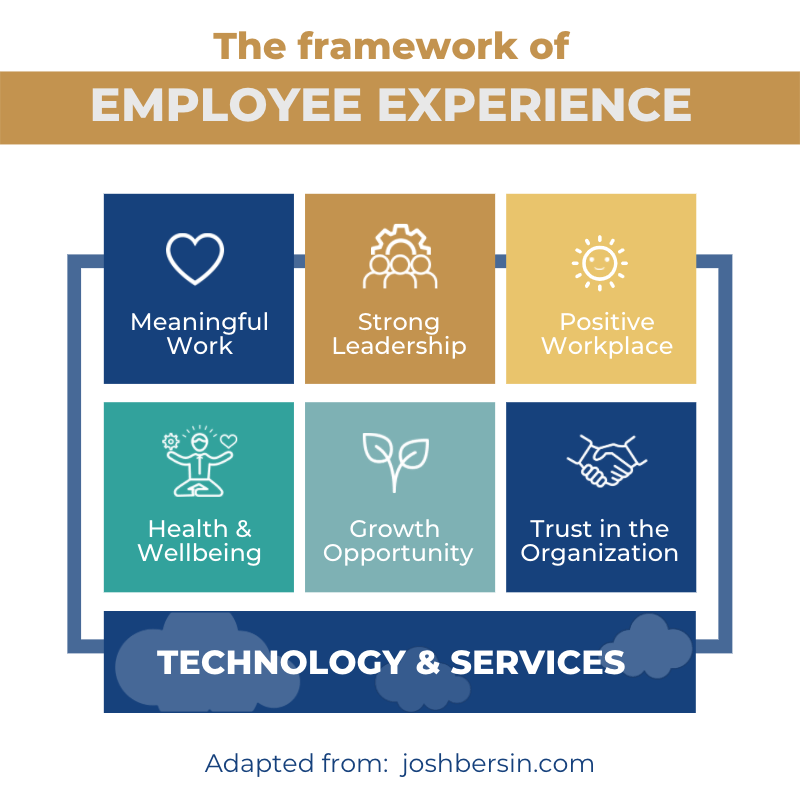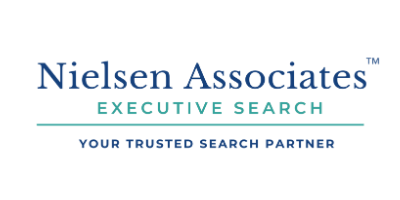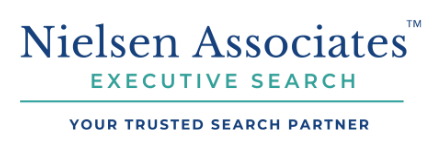Making the Case for EXcellence
Imagine you could poll workers to find out what they really think, and you asked them this true or false question.
Most likely, the majority of respondents would unanimously agree both of these statements are true; except (perhaps) for a small percentage who actually admit they thrive on toxic drama.
True or false?
When you like what you do for a living,
you’re a happier human.
And —
No one wants to work in a toxic workplace.
It's a no-brainer, isn't it?
So the responses to your poll wouldn’t be too surprising: We know for sure workers at every level want to be happy. But what IS surprising are the stories we hear about companies who have no formal employee experience (EX) strategy. The rationale may sound something like this:
“There’s no budget for culture enhancements.
Whenever we invest in people, they end up quitting.
Our turnover rate is a little high, but it always has been.
We’re used to it.”
Then there’s the equally surprising stats which offer a more official account of what’s really going on inside offices everywhere:
- “Over 46% of younger workers now say they feel stressed “all the time,” and almost half state that their employer “did nothing” to help them.” - Deloitte Global 2021 Millennial and Gen Z Survey
- “80% of workers ranked wellbeing as a top trend, identifying it as important or very important to their organization’s success.” -2020 Deloitte Global Human Capital Trends
- “Nearly a quarter of workers feel their employer has personally discriminated against them. And one in five feel personally discriminated against “all the time” because of some aspect of their background.” -The Josh Bersin Company 2021
- “37% of workers are thinking of leaving their jobs or are already preparing to make the move.”
-Yahoo Finance 2021
Getting Buy-in
One reason Employee Experience (EX) hasn’t gained traction at many companies has to do with perception. EX is about more than fun perks and catered lunch; and it’s much broader than employee engagement. Over time, EX has matured into a cross-functional business strategy that shapes how workers holistically experience a company. EX is the what, why, who, and how of work across an entire organization. When the right EX strategies are in place, there are REAL business outcomes and everything improves - from your ability to attract and retain talent, to customer satisfaction. In a volatile and uncertain marketplace, EX strategies improve an organization’s ability to adapt, innovate, and thrive.
If your leadership team
could use some convincing,
here are business outcomes that illustrate why EXcellence is important.

So what exactly is EX?
Is it a tech strategy?
Yes.
Is it an HR strategy? It sure is.
Is it an employee strategy? Definitely.
Is it a customer strategy? Without a doubt.
Employee Experience is far too big to cover comprehensively in a single blog article. It encompasses the work we do, and how we do it. But it's also about the teams we work on; our direct managers and how they coach and support us; our health and wellbeing; the digital, physical, and cultural workplace; how we grow and develop; and how much we trust the organization that we work for. EX is an organizational design strategy that puts employees at the center.
EX Strategy Maturity
The more robust and mature your EX strategy is, the greater the ROI. If you’re just starting out, you may begin with visible initiatives that clearly show employees they matter. These are culture strategies that are hard to miss - for example catered lunch at the quarterly meeting, or a holiday gift in December.
Companies who want to see greater ROI often put more pervasive EX strategies in place that are felt during all stages of the employee life cycle— from the very first touchpoint during recruiting, to the onboarding experience, to performance management, career development, leadership succession, and retirement.
The most advanced EX strategies are supported by a technology infrastructure that provides a consumer-grade, seamless experience for employees. This means there’s a flexible enterprise system in place where it’s easy to process all kinds of transactions, collaborate, access information, and be productive and effective. Advanced people analytics and real-time data insights empower business leaders to make relevant business decisions.
Creating the Irresistible Organization
So where do you stand; how do you cut through the noise; and where should you focus first?
Josh Bersin and Deloitte have done significant work to define what EX really means, why EX matters so much, and how to achieve EXcellence in a post-pandemic workplace and labor market that’s disrupted and extremely competitive. (New jobs are being created at a record rate, remote work is now standard, and demand for labor is explosive. According to EMSI, there are 24% more jobs in the US than there were a year ago.) Here are some of their discoveries, key insights, and a framework for EX that organizations can adapt:
- The EX framework includes 6 Key focal points, with technology and services as the core foundation.

1. Meaningful Work
What it looks like:
- Job and values fit
- Autonomy and agency
- Agile teams
- Supportive co-workers
- Time to focus, innovate and recover

2. Strong Management
What it looks like:
- Clear goals with stretch opportunity
- Regular coaching and feedback
- Focus on management development
- Transparent, simple performance management

3. Positive Workplace Culture
What it looks like:
- Tools, processes and systems to get work done productively
- Appreciation, recognition, and rewards
- Flexible hours and workplace
- Inclusive and diverse
- Sense of belonging and community

4. Health and Wellbeing
What it looks like:
- Safety and security in all aspects of work
- Personal fitness, health and wellbeing support
- Psychological and emotional wellbeing and support
- Family and financial support

5. Growth Opportunities
What it looks like:
- Open, facilitated job and role mobility
- Career growth in multiple paths
- Many forms of learning as needed in a culture that supports learning

6. Organizational Trust
What it looks like:
- Mission and purpose beyond financial goals
- Transparency, empathy, and integrity of leadership
- Continuous investment in people
- Focus on society, environment and community
- Trust, inclusion, transparency, and caring make the biggest impact. According to Bersin, transparency, mission and purpose beyond financial goals, integrity of leadership, and a continuous investment in people make the biggest EX impact.
- Wellbeing is growing up really fast. Companies are now going further than healthcare benefits to design everything with wellbeing in mind, including operational policies and business processes. Conversations have reached far beyond workplace safety to encompass topics like burnout, digital and communication overload, mental health, zoom fatigue, work-life balance, and mindfulness.
- Data insights and employee feedback are a big area of opportunity. Research shows a critical part of EX is listening - which involves asking for employee feedback and collecting real business data — and then paying attention. Yet only 11% of organizations said they were able to produce information on their workforce in real time, and 3 in 5 companies don’t currently use advanced people analytics to inform business decisions. Most companies have feedback surveys and engagement data floating all over the place. It’s vital to collect, centralize and consolidate data in order to extract meaningful insights from it.

Helpful Resources:
We’ll dive deeper to explore what it takes to design an irresistible organization in the coming months. In the meantime, be sure to check out this list of Employee Experience references, resources, and experts.
- 2020 Deloitte Global Human Capital Trends
- A call for accountability and action : THE DELOITTE GLOBAL 2021 MILLENNIAL AND GEN Z SURVEY
- The Definitive Guide: Employee Experience | The Josh Bersin Company
- Jacob Morgan, The Employee Experience Advantage












